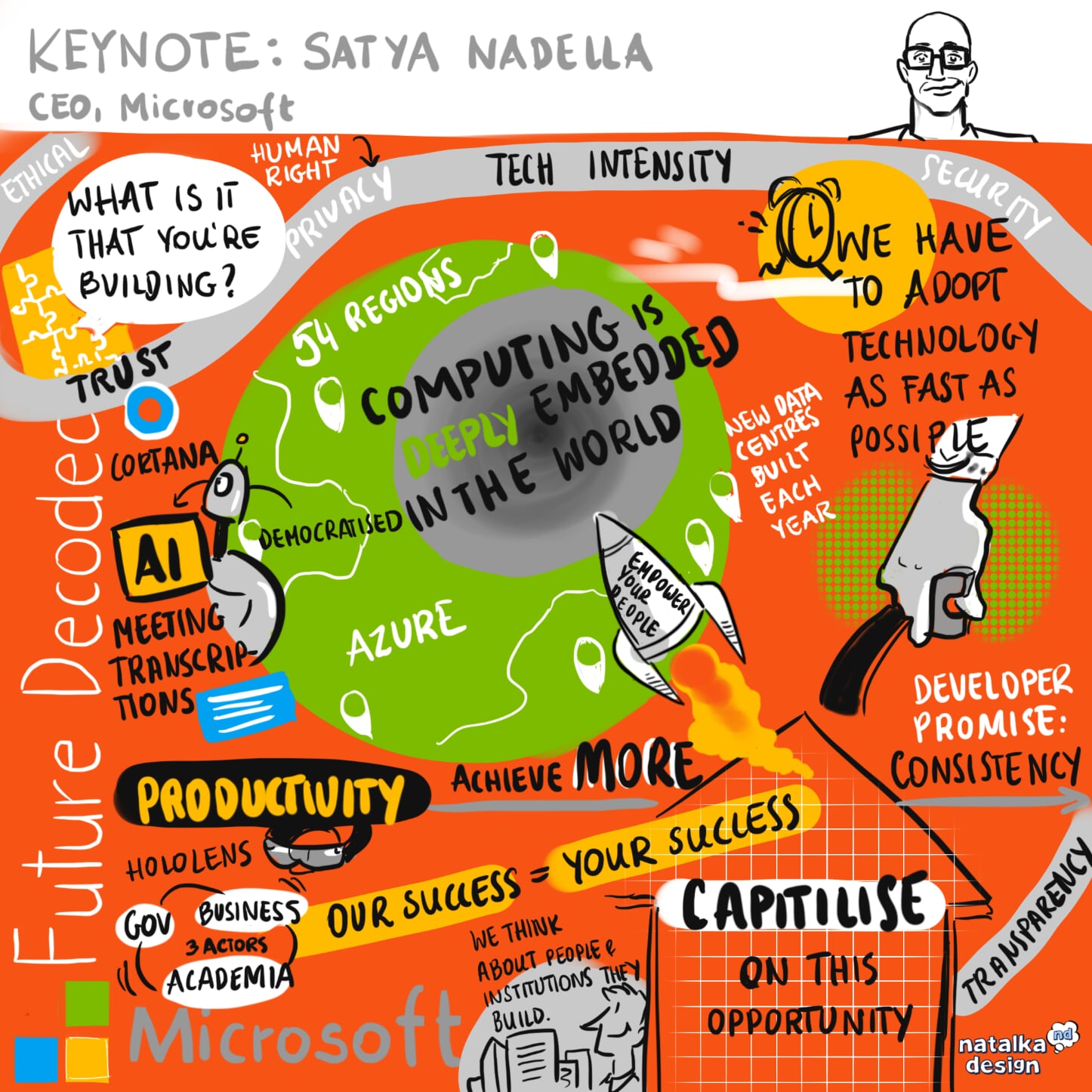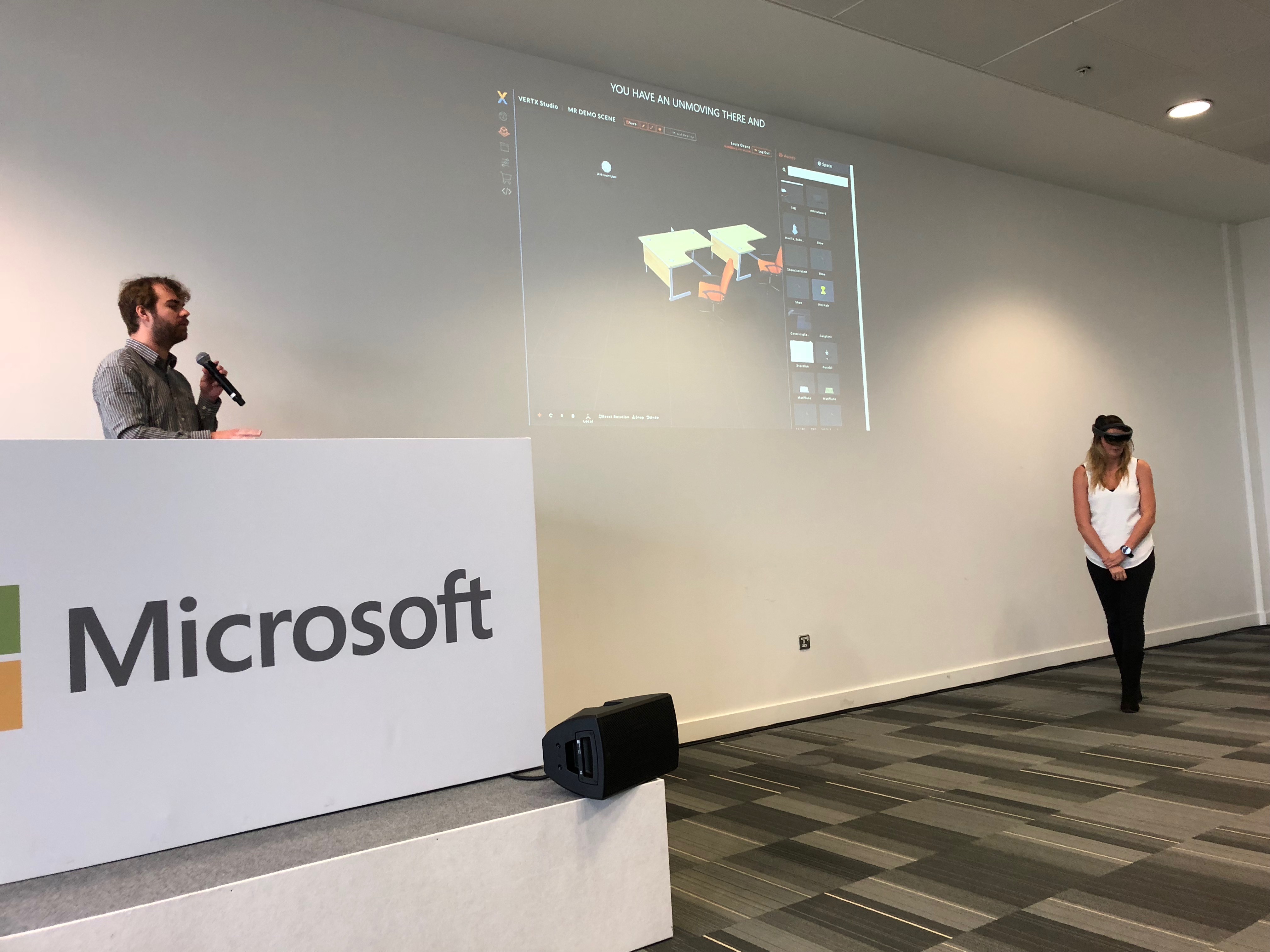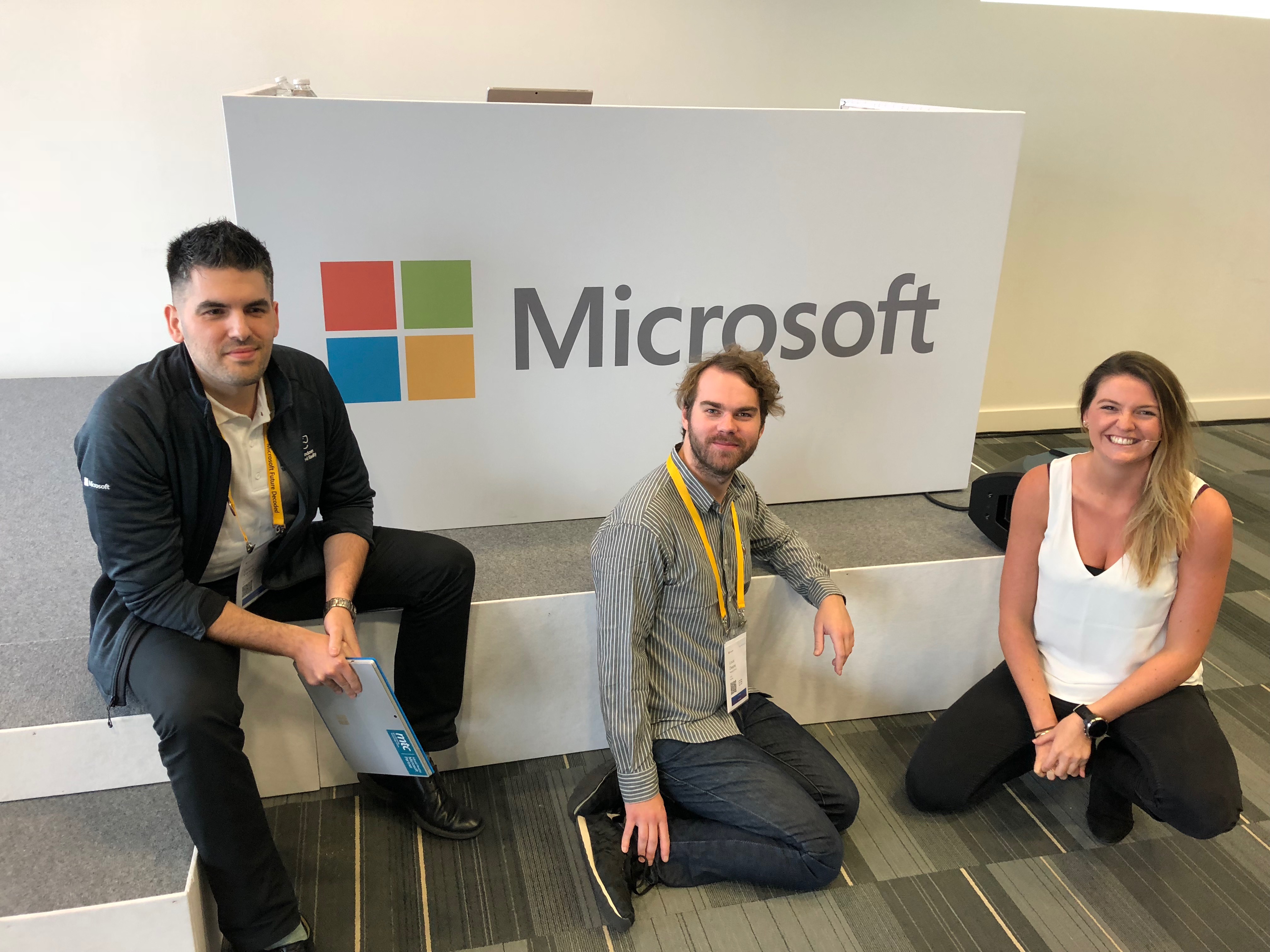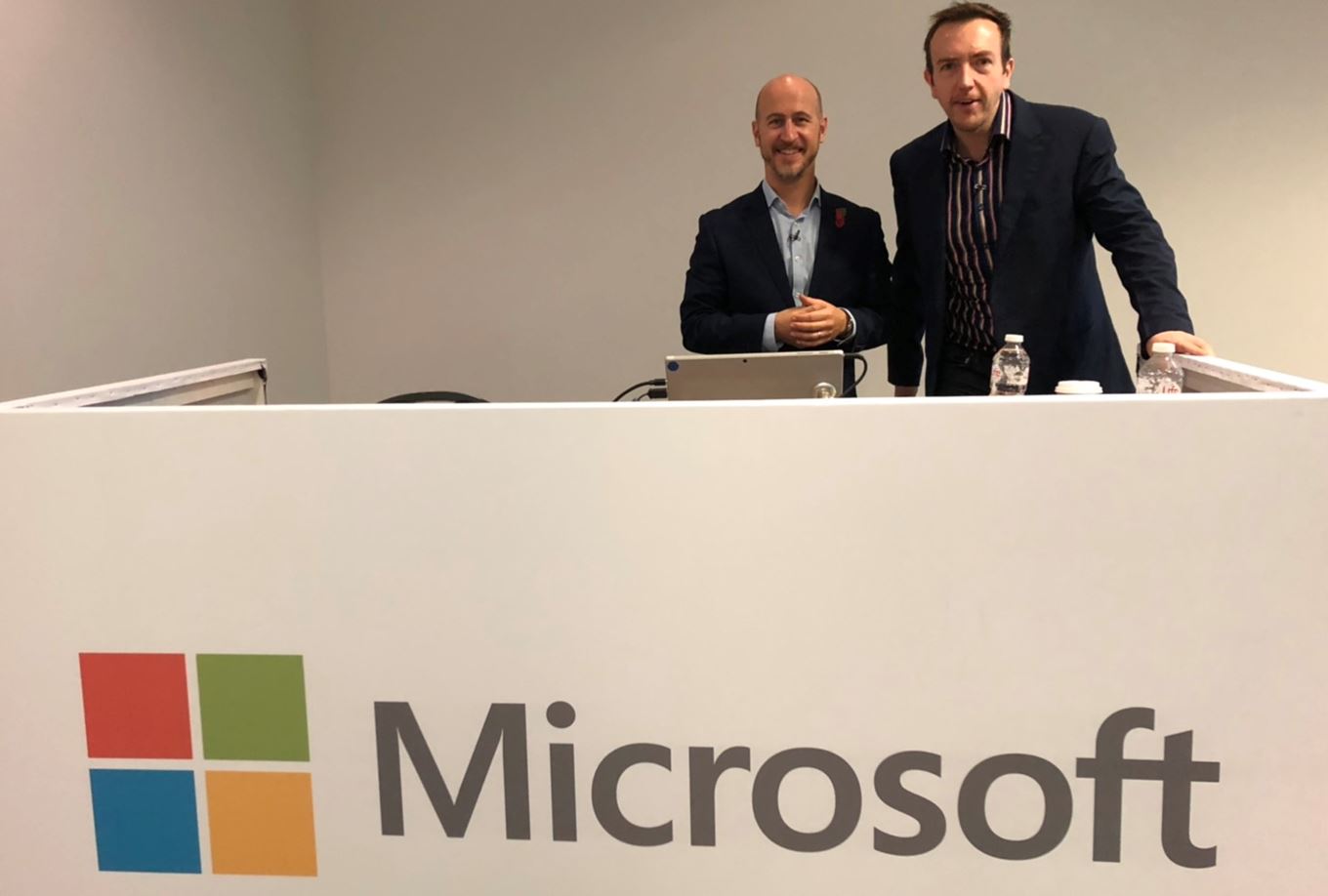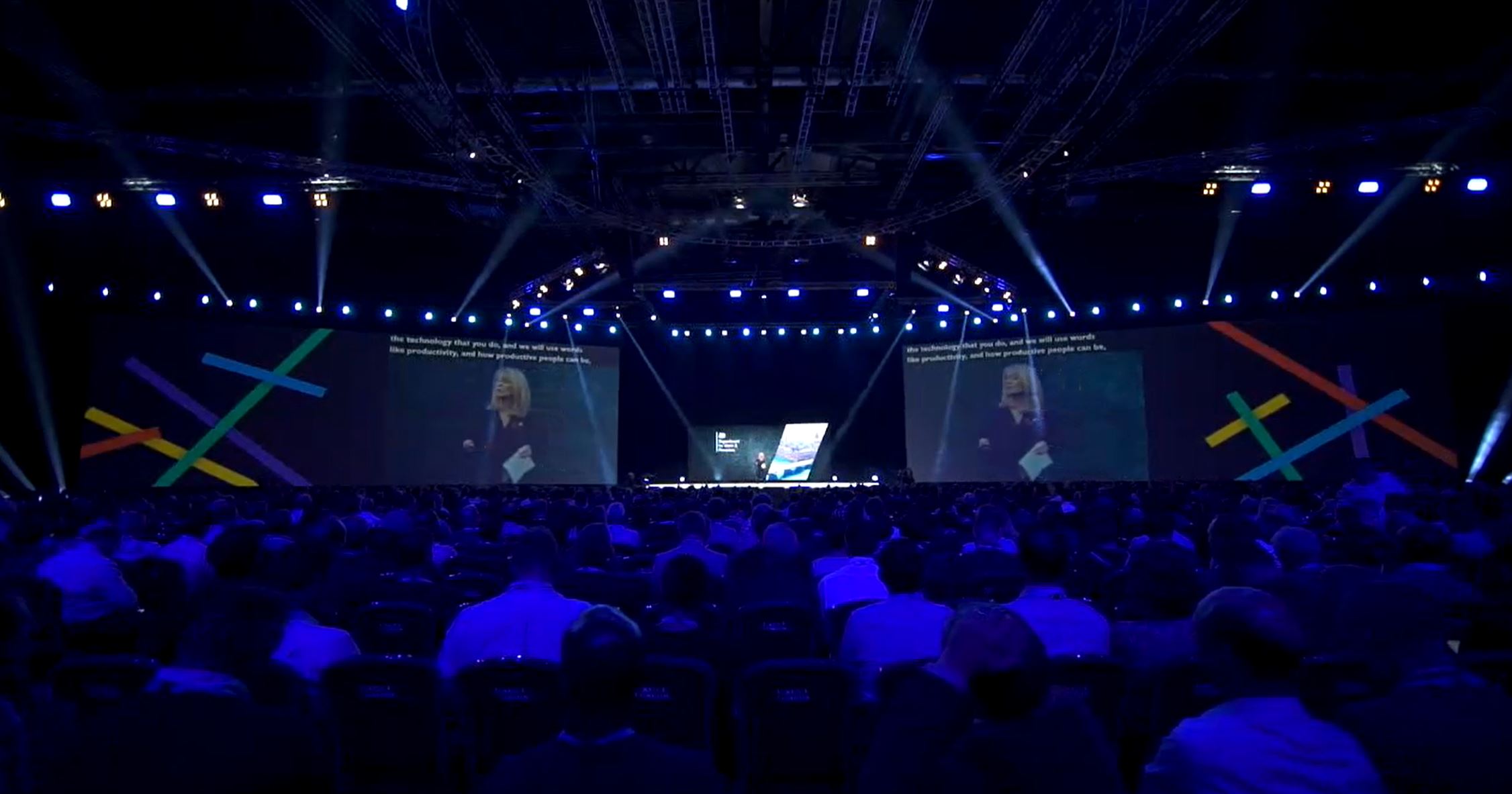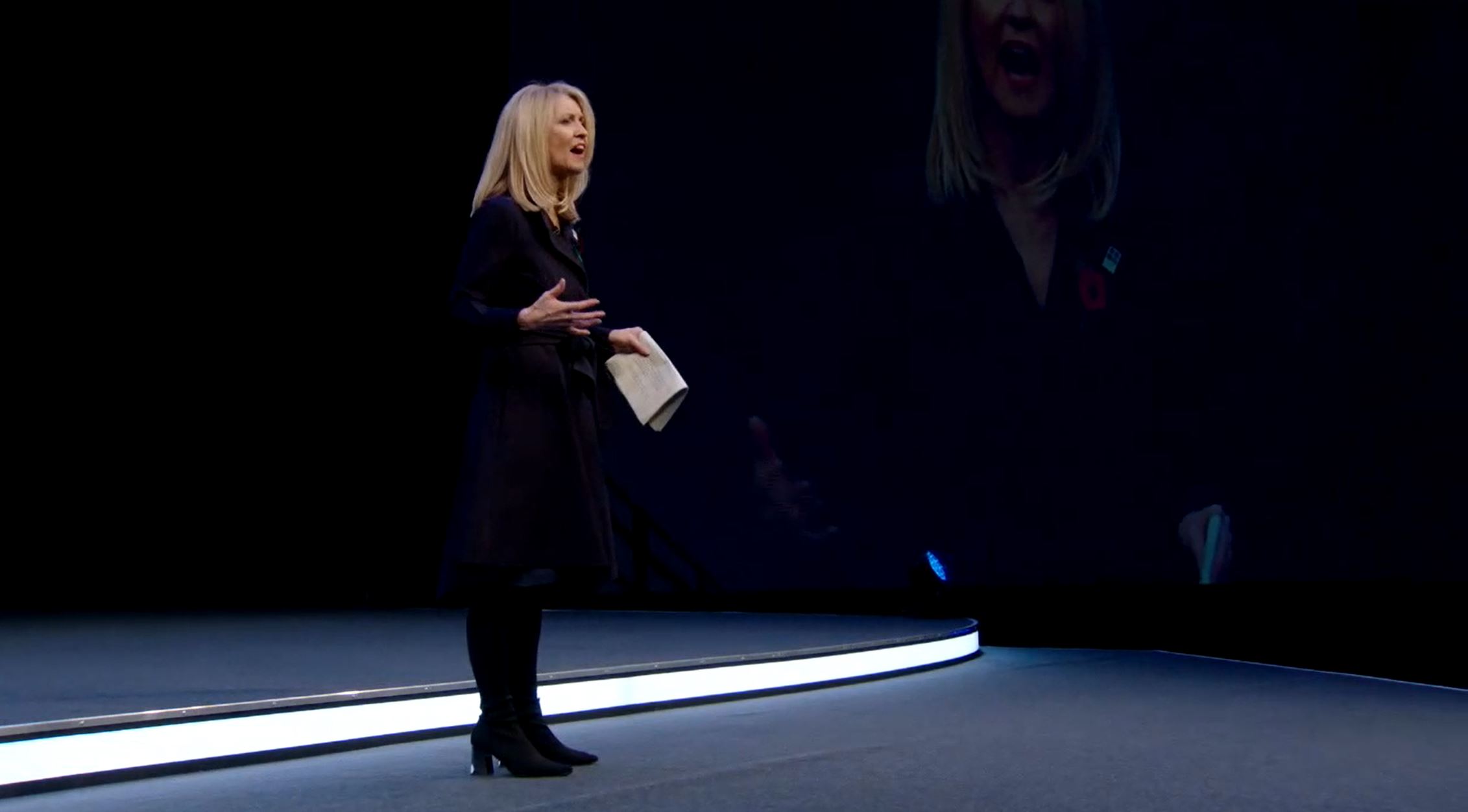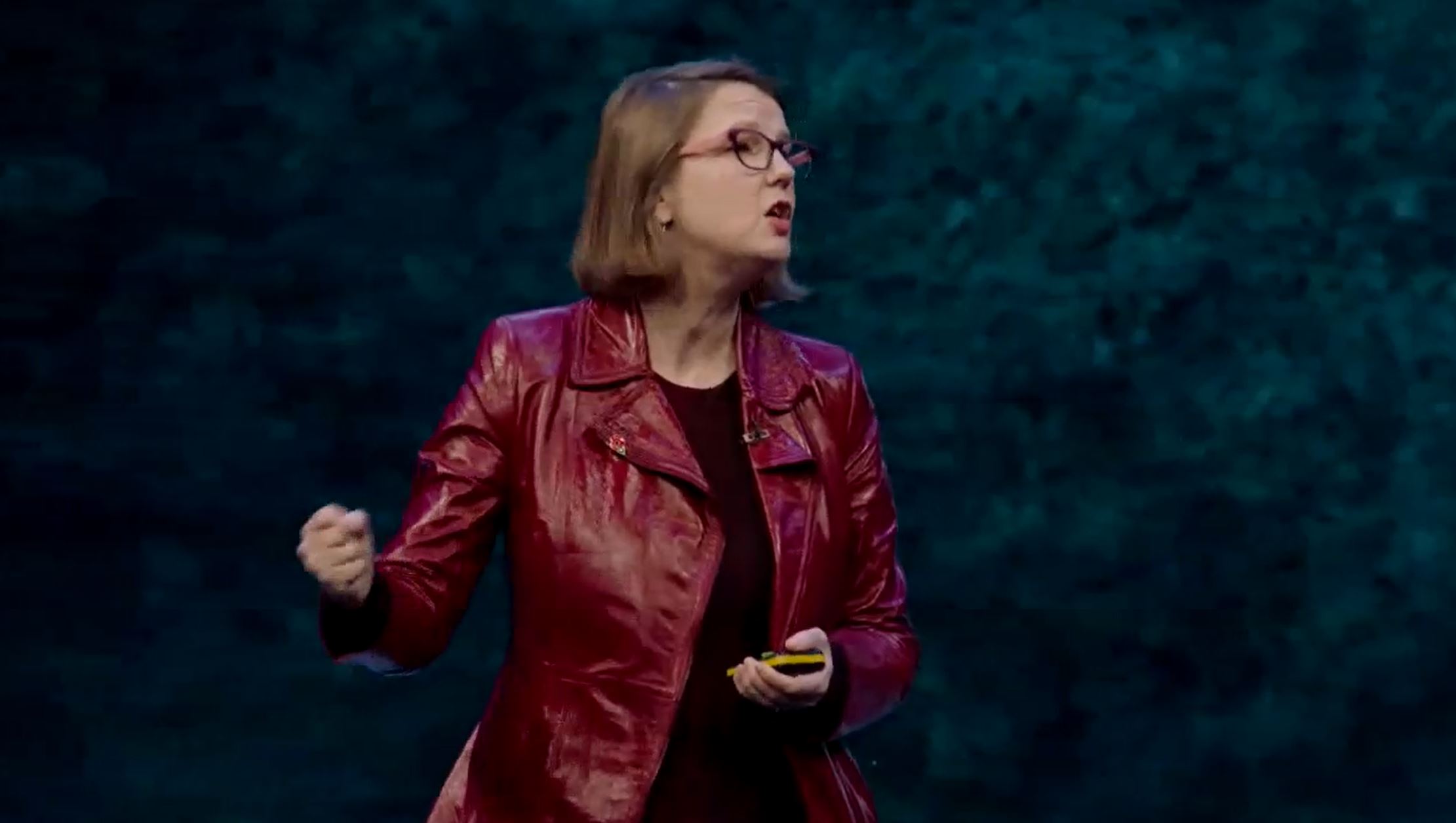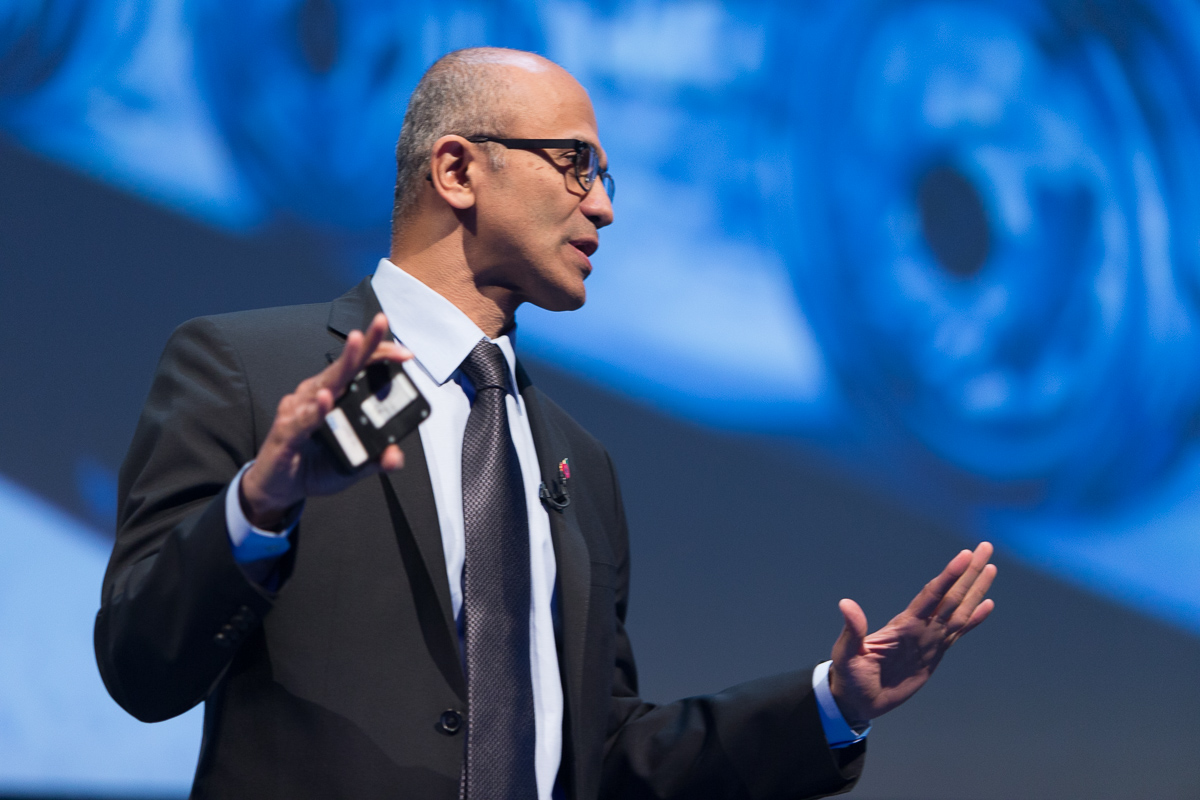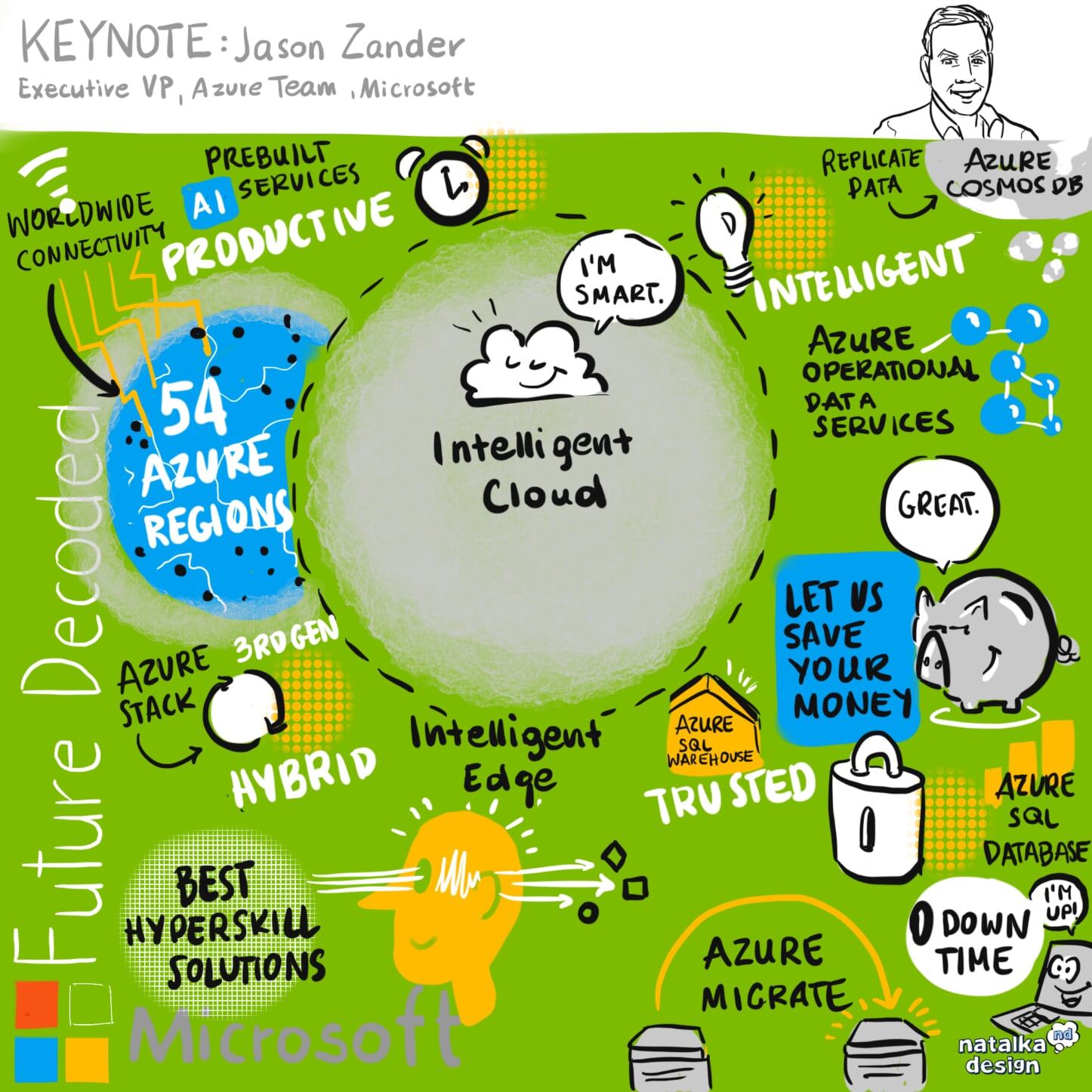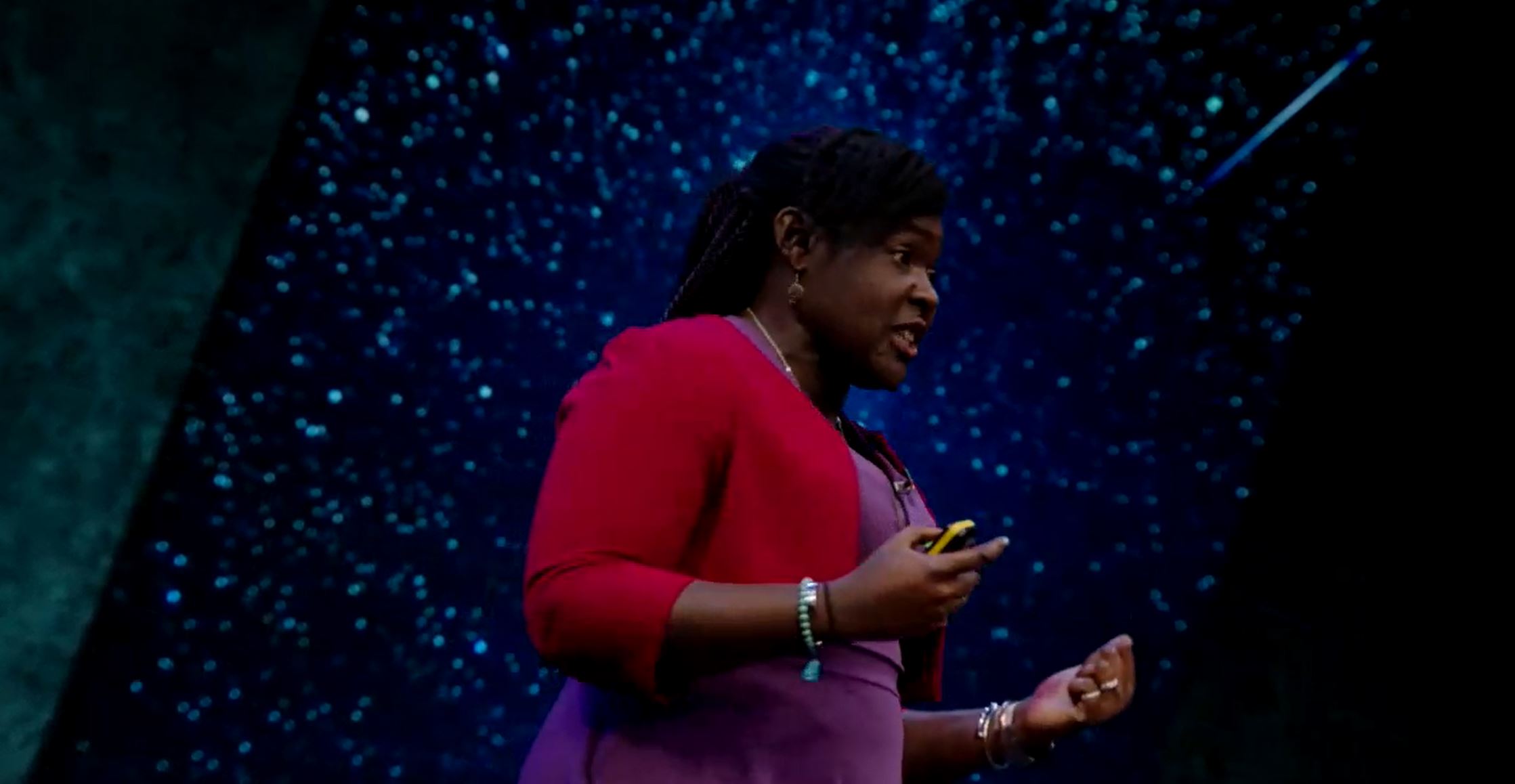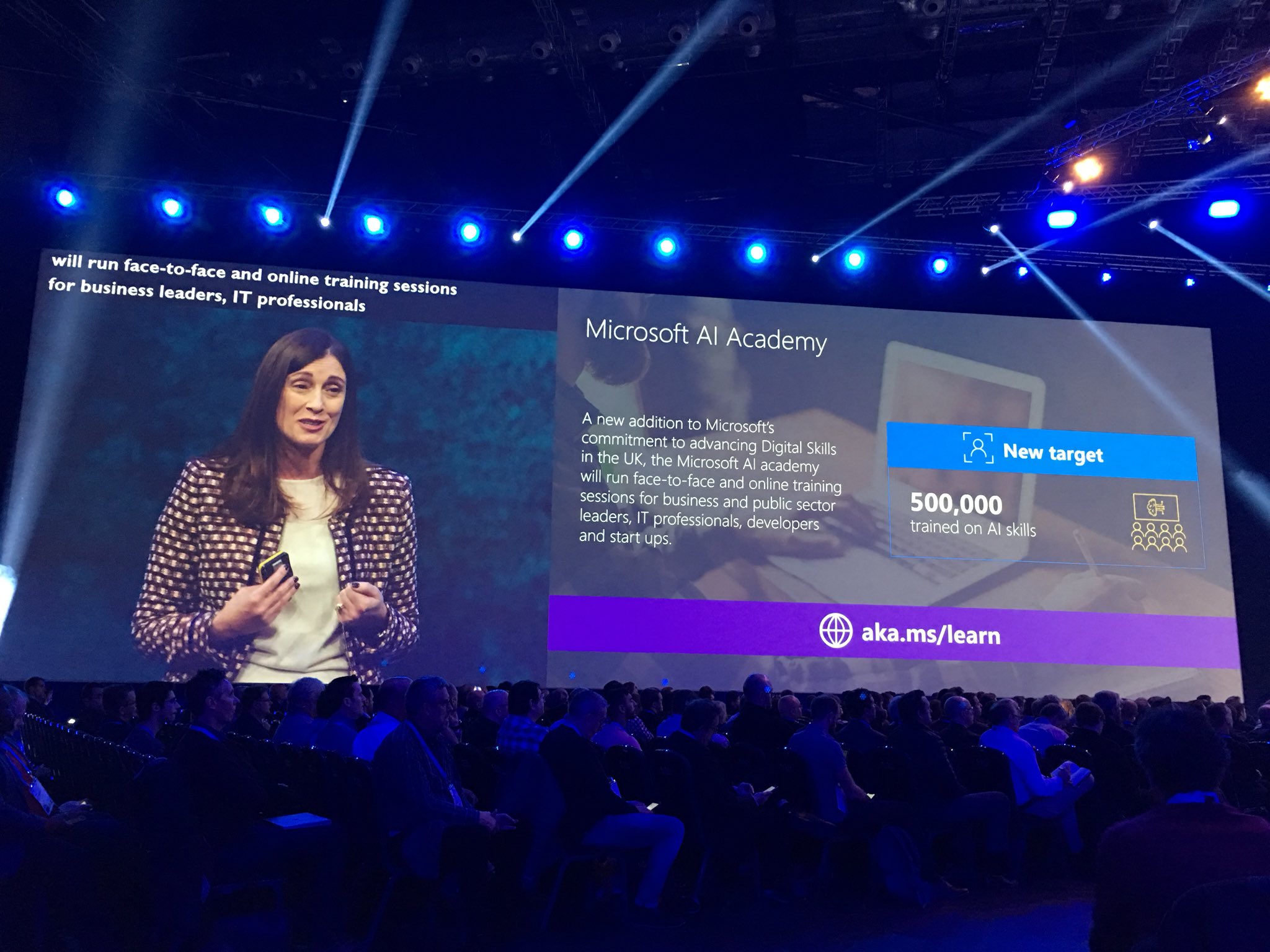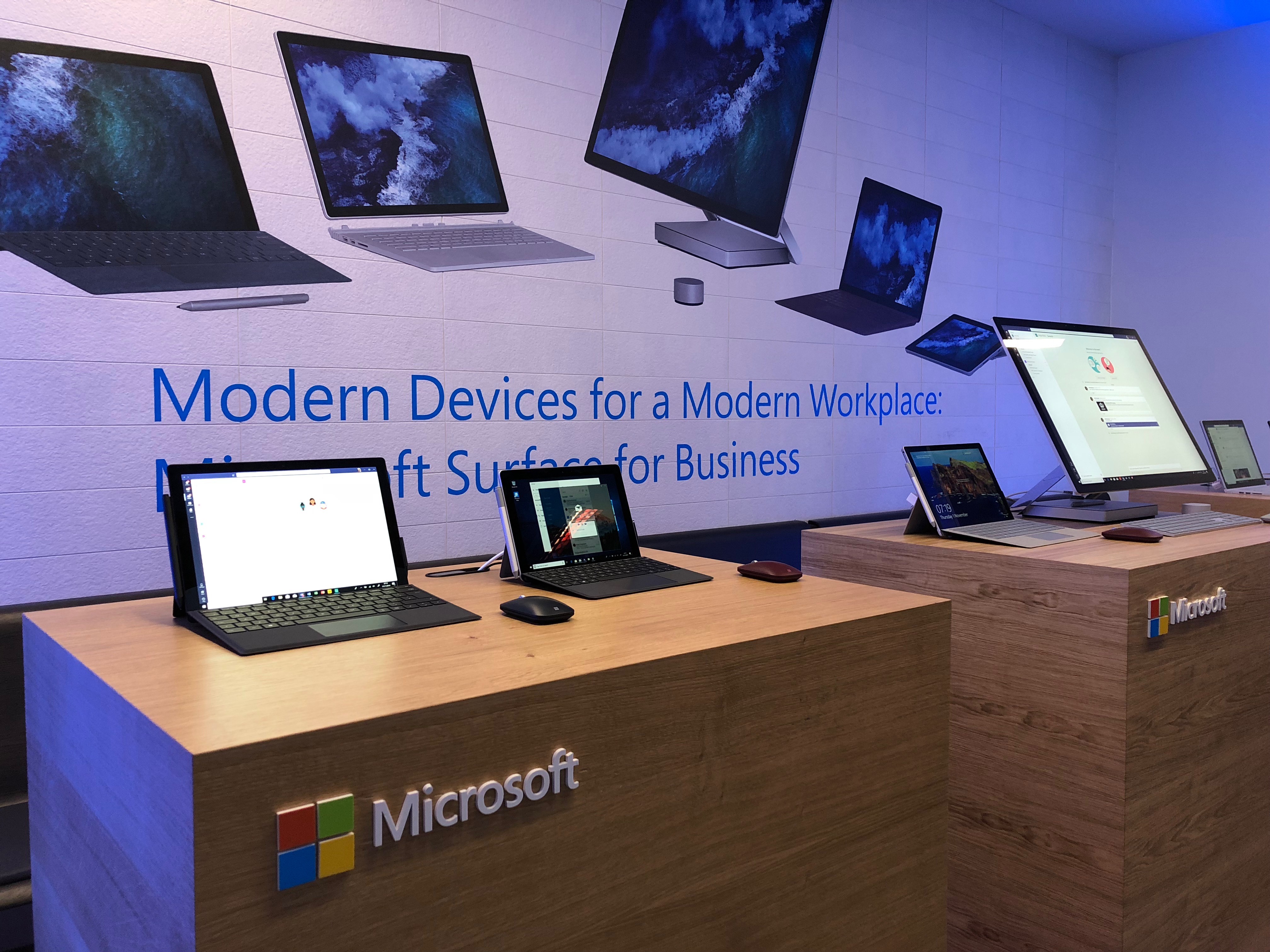
Future Decoded 2018: Day Two – as it happened
- Day two of Future Decoded gets under way in London, Satya Nadella gives keynote
- Microsoft announces deal with NHSScotland to revolutionise healthcare
- Centrica forms strategic partnership with Microsoft
- Future Decoded: Day One – as it happened
- New research shows UK firms at risk of falling behind due to lack of AI strategy
5:20
That’s it from Future Decoded for today – and this year. We’ve seen some amazing talks, enjoyed meeting countless partners, customers and fans, and got our hands on some incredible technology. Thank you to everyone who attended or followed our live blog. You can stay up to date with the latest Microsoft news at our UK News Centre.
Goodbye.
5:17
Syed: As a leader you need to be able to galvanise the team and lead them in a direction. You need confidence at execution and humility at evaluation. Listen to the people in your team, and that provides a leader with what they need to make a sensible decision.
Tech can be fundamental to helping healthcare. I’m interested in how tech can improve diagnostic provisions like radiographs.
I’m excited about the way tech is shaping our world, and it can do that in a profound way in a number of sectors. My biggest fear is the amount of time that some young people spend on smartphones.
My new book is for kids aged 8-14, to help them make sense of the modern world. They need the mindset to feel comfortable about a dynamic, external reality.
5:07
Syed: The scientific revolution wasn’t a revolution in talent, it was a revolution in psychology. That happens in schools, too. If you get kids in a growth mindset, amazing things happen.
4:59
Syed: Growth mindset means liberating our talent. I spent some time with Satya Nadella last year and asked him how the transformation of Microsoft occurred. In CEO, he sees the “C” as culture. His priority was getting the culture at Microsoft into a growth mindset. He told me we need to shift from a culture of know-it-alls to a culture of learn-it-alls. As a result, I see a psychological change at Microsoft.
4:49
Syed: When you get to the top of healthcare you don’t make mistakes, which sounds great. But there is a danger. What happens when something goes less well than usual?
There is always the opportunity to get better. In aviation they learn how to do that.
If I’m super talented in healthcare and get everything right and someone dies, it must be an unavoidable death or “one of those things”. The self-justification process takes the sting out of it but prevents learning.
The problem in healthcare isn’t a lack of talent but that talented people are in the wrong mindset.
4:44
Syed: Talent is a real phenomenon that explains some of the performance from people but it isn’t enough. A growth mindset lets people learn from mistakes and failures.
4:39
Syed: I was British table tennis champion for 10 years and played in a couple of Olympics. When I got to the number one position, more than half of the top players in the country came from the same street – Silverdale Road in Reading. It’s an ordinary street. The explanation for this wasn’t talent, because it was a diverse group, we didn’t share a genetic make-up.
We had a great coach and leader, he put us in the right mindset. We had healthy competition, which was a galvanising force. There was also a purpose-built 24-hour table tennis club down the road. Ordinary people became extraordinary players.
4:30
We are back in the main hall for the final keynote from Matthew Syed.
4:15
The Microsoft for Startups team is enjoying Future Decoded.
3:53
Ramanan leaves us with the point that quantum hardware is still at least five years away.
Now it’s just over half an hour until the final keynote in the main hall.
3:45
Quantum Computing is based on quantum superposition… 0 & 1 at the same time … oh, wait, now there’s a cat involved – that’s quantum computing in a tweet for you – basically it’ll happen in the future so you’ll have to wait – but it’ll solve mazes really fast #futuredecoded
— Andy Powell (@andypowe11) November 1, 2018
3:38
He’s not wrong…
This quantum computing malarkey is quite complicated. #FutureDecoded pic.twitter.com/a3velN775b
— Jamie Prady (@JamiePrady) November 1, 2018
3:34
Ramanan: Quantum can be used for encryption. You add two prime numbers together and you get an encryption key. You can only unlock it if you have both numbers. Classical computers would take a billion years to crack the latest encryption.
It would take about 100 seconds on a quantum computer.
3:30
Ramanan: Classical computers are not dead, they are very good at what they do. We have spent years fine tuning them.
Most of the work of creating a quantum application will be done on classical computers using C#. On a 16 gig machine you can run about 30 qubits. You can run about 50 qubits on the world’s most powerful computer.
Once we have hardware available we can start running algorithms on it.
3:20
Ramanan: Imagine the power of quantum computing is like a maze – you could try all the routes at the same time.
3:13
Ramanan: There are a huge range of problems we can tackle with a quantum computer. Nitrogen makes up 80% of the atmosphere and is found in humans. We find it in fertilizer, too. Traditionally, farmers got nitrogen into the soil by putting dead plants into the ground, but this isn’t scalable, they can’t produce enough fertilizer. Scientists invented a new process and created ammonia to help. But that’s not an energy efficient process – it uses 4% of the global energy produced every year.
Simulating alternatives has been difficult as we can’t understand the process. We could use 170 qubits to solve this problem.
3:07
Ramanan: There’s a lot of hype about quantum computing but I want to look at what it can do. First, quantum mechanics is weird, there are no nice patterns in quantum computing like there are in classical computing. But we can exploit this weirdness to build computers that go far beyond what we have done before.
We want to build a quantum computer to tackle big problems such as creating cheap fertilizer, carbon capture, materials science and machine learning.
3:00
We’re under way in the quantum computing talk.
2:55
In case you missed Satya Nadella‘s keynote this morning, we’ve put together a pictorial reminder of the biggest topics he covered:
2:46
Huge queue for this quantum computing talk. A lot of people packed in to hear the next generation of tech.
2:32
Next up it’s Anita Ramanan, a Software Development Engineer at Microsoft, talking about quantum computing. Then we head into the final keynote with broadcaster and author Matthew Syed at 4:30pm.
2:20
Waiting in the queue to try some AR/VR experience based on manufacturing use cases. #AR #VR #AI #IoT #IIoT #FutureDecoded @MicrosoftUK pic.twitter.com/ysRJqlzvoZ
— SiN@N╮ (@KahveciSinan) November 1, 2018
2:12
Fear: To get started, you can build your own app for HoloLens, you can build with a partner, with Microsoft or get an off-the-shelf solution.
2:08
Varela: Everything we do has a business case. Our mixed reality platform has reduced manual assembly time by 25%, reduced installation mistakes, speeded up knowledge to new employees and enabling a flexible workforce.
2:01
Varela: We want to transform how workers see and manipulate enterprise data. Delivering the right data, at the right time. We are growing our partnership with Microsoft. We are also working with health companies across the world to develop frameworks so we can get this technology into businesses.
1:51
Deane: VISR runs a start-up programme at Hull University for companies who want to use mixed reality to solve real-world problems.
1:48
HoloLens demo:
1:42
Fear: We are seeing momentum in mixed reality, this is not a new technology. There is a lot of traction around this – in retail, in manufacturing, healthcare, education, engineering, public sector and entertainment. This is being delivered to our partners.
Deane: Most business happens in the real world. The making of things happens in real spaces – factories etc. Part of teaching a machine perception, we have to teach it to model a room.
1:35
Fear: Mixed reality is a blending of physical and digital world. Microsoft is doing that through a series of devices.
HoloLens is an open headset – you can see and interact with the world around you. It senses the room six times a second and can remember the holograms you created and where they are.
People want solutions in Natural Language Interaction, Object Recognition or Real World Perception.
1:25
We are waiting to hear from Azure Product Marketing Manager Anna Fear, Louis Deane, from VISR; and David Varela from the Manufacturing Technology Centre. They are talking about mixed reality and the future of computing.
1:05
So, a flash mob just sprang up on the concourse. This was unexpected…. but amazing!
12:48
Another full theatre for our final session at #FutureDecoded! pic.twitter.com/HUk8B9yuSZ
— Modality Systems (@modalitysystems) 1 November 2018
12:30
That’s it for Hector and Neil’s talk. We’re heading back to the exhibition hall.
12:18
Milliken: Using Microsoft Stream, you can automatically generate transcripts for your videos.
Minto: Every meeting in Teams will be transcribed, so people can search for text and find what they want. We have Immersive Reader that can break up and highlight words. There are dyslexia solutions built in to Microsoft technology – Windows Hello, Dictate in Office 365, Read Aloud, Spellchecker, Cortana reminders, and Office Lens.
12:09
Saqib Shaikh, the developer behind Seeing AI:
Proud moment at the #FutureDecoded keynote this morning – @SatyaNadella @JennyLF @EstherMcVey1 talking about accessibility to 5000 partners and customers – “you can all make a difference”. I remember when this was a niche topic!☺️
— Saqib Shaikh (@saqibs) 1 November 2018
12:05
Minto: Microsoft AI automatically puts Alt Text on pictures so blind people know which images are on a screen.
Seeing AI is now used by more than 200,000 people. It’s a free app that recognises object and faces, and it reads documents. It turns the analogue world into voice. Instant text to speech is amazing. But is it just for blind people? How many people around the world can’t read? Think about inclusive design.
The accessibility checker in Office 365 is in the main toolbar. We made a decision to feature that prominently.
11:58
Minto: There is a toolkit on inclusive design: aka.ms/inclusivedesign. My favourite is the Read Aloud function in Edge – any web page, any PDF, any document can be read aloud. Tens of thousands of people are using that feature every month.
11:50
Minto: I was the first to see touchscreens and eye tracking because it was initially developed for people with disabilities.
The only way we can get the talent we need is to assess all of our operations to ensure they are accessible.
It all takes leadership. We have to be learn-it-alls. Don’t pretend to know it all.
11:44
Milliken: In the future, we will see air gestures and haptics for “air touch”. They are going to hit the mainstream sooner than you expect. There will be more motion sensors, we are going to be thinking about neural interfaces. But it’s also important to be thinking about ethics when developing all this technology.
11:40
Milliken: A child born in Japan in 2007 has a more than 50% chance of living to 100 years old.
At Atos we see lots of technology. There is so much going on that this fragmentation has an impact. Things are changing all the time and this has an impact. Disability is a mismatch between a person and their environment that creates a barrier to them participating fully.
Designing for inclusion helps everyone. Accessibility puts customers, employees and you in control.
11:34
Minto: It’s important that we empower all Microsoft staff to talk about accessibility so they have the right information when they meet customers. There are a billion people with disabilities across the world. Digital transformation must increasingly represent the diverse population it aims to serve. Technology is reaching people with disabilities more and more, there is a computer in every pocket, and we have to get on top of this.
There are permanent, temporary and situational disabilities. Microsoft considers that they all have the same disability. Who knows how to type one-handed? Press the “shift” key five times and it brings up Sticky Keys. That’s been there since Windows 95.
11:29
We are about to hear from Hector Minto, Senior Technical Evangelist on Accessibility at Microsoft UK, and Neil Milliken at Atos.
11:21
Matthew Bateman, Managing Director for Field Operations at British Gas, said: “Just over a year ago we announced that Centrica had transitioned to Microsoft Azure, a move at the heart of our digital transformation ambitions. This announcement marks the next stage on that journey – building cutting-edge intelligence into the way we run our field operations to improve the service we deliver for our customers in their homes.
“If a boiler or home appliance breaks down, a customer wants us to fix their issue quickly and to know when an engineer will be there. Working with Microsoft, we will develop a seamless digital journey for our customers, offering more flexibility and reliability for engineer appointments.”
Read the full story here.
11:09
Centrica, the leading international energy and services firm with well-known customer brands British Gas, Dyno and Direct Energy, has formed a strategic partnership with Microsoft designed to transform the way its 12,000-strong team of British Gas engineers serve customers across the UK. The agreement is at the heart of the Centrica purpose to “provide energy and services to satisfy the changing needs of their customers”.
11:03
NHSScotland has signed a deal with Microsoft to revolutionise healthcare in the country, in a move that will cut waiting times and improve patient care.
As part of the “landmark” agreement, NHSScotland will merge more than 100 separate computer systems and give its 161,000 staff access to Office 365 so they can spend more time focusing on patients.
GPs, consultants and support workers will now be able to communicate on one digital platform, allowing them to share patient information more easily and reduce waiting times.
10:54
McVey: I work every day with disabled people who have had their lives transformed by you. Thank you.
(That’s the end of McVey’s talk)
10:48
McVey: There are 1bn people with disabilities across the world. Creating for accessibility is good for business, good for society and good for life. In the UK, we are tech leaders.
The cost of devices has come right down, we have enabled people to do more. Solving the problem disabled people face changes everybody’s life.
Microsoft has Windows Magnification. There are a plethora of apps helping people overcoming impairments. Microsoft’s SeeingAI app helps people with visual impairments.
I’m looking for the next chapter. How we are going to close the gap in employment for people with disabilities. We have to tap into everyone’s talent, a world that includes everyone. A developed world is an inclusive world.
Government is putting money into technology, with funding schemes to help R&D. We want to be a world example of what we can do. A world example of the vision.
10:41
McVey: Technology is the great equaliser for people. In 2013, I set up a scheme called Disability Confident. Confident was a non-challenging, non-threatening word and didn’t stop people asking questions.
Businesses could ask questions and Government would work with them to offer support and information. It was helping them into work.
Microsoft has been a strong support and guider from the beginning. They are part of our Business Leader team.
We now have 3.5m disabled people in work but there is still a gap and we want more in work. We can narrow the gap between disabled and non-disabled people. It’s about sweeping away perceptions, seeing them in a different way.
10:36
Esther McVey, Secretary of State for Work and Pensions, now on stage.
10:34
Lay-Flurrie: The future is exciting. In 2014, we started our hackathon programme. We had 10 projects, of which EyeControl was one. This year, there are 250 projects. It talks to the power of creating things that impact people and can lead the future.
Products don’t all have to be techie. Take the Xbox Adaptive Controller, a project launched in 2016. That’s now been shipped, and costs just £75. It looks cool and is amazing to use. But the packaging was redesigned to work better for the community we were targeting – those with limited mobility. We got rid of plastic, and the stuff you need a knife to get into. You can open the box with one finger.
If you want to partner with us on accessibility – let’s go.
10:28
Lay-Flurrie: One of my favourite parts of Future Decoded so far has been the captions on all the videos. Built into PowerPoint, you have Translator, which was developed by a deaf person. At the click of a button, you can add captions so people can follow along. That benefits us all.
One-in-nine people has colour blindness. We added a tool to help with that in Windows.
These are some of the things that have come from investing in our culture. Our customers say this is helping them, too. We are empowering people.
10:21
Lay-Flurrie: If we design through the lens of accessibility, we will create better products. There are three pillars to our approach – the first is culture. If you have talent with disability in the fabric of your environment, you will produce better products.
Employee communities are so important. I started at Microsoft to work on Hotmail, and I joined every deaf group I could find. We have an annual conference with 1,200 employees who attend.
But it’s not just about the talent you hire, it’s about the talent you nurture. Every Microsoft employee has to do training on the language to use and not use, how to add audio descriptions and subtitles to videos.
If you try to make your stuff accessible at the end of the process it will be expensive. If you add it from the beginning it will be easier and you will create better things.
10:14
Jenny Lay-Flurrie, Chief Accessibility Office, takes to the stage.
Lay-Flurrie: Accessibility impacts us all. It’s big.
10:12
It takes a diverse group to create technology. Every walk of life, every part of industry and economy is being digitised. There isn’t a place not being digitised, no industry that’s not being transformed by technology. That’s an opportunity https://t.co/0SSU3F9MLU #FutureDecoded pic.twitter.com/Mv8V1ngfUl
— Microsoft Business (@MSFTBusinessUK) November 1, 2018
10:10
Nadella‘s talk is over. That was amazing.
10:07
Nadella: We need to be mindful of the use cases of AI. When we put a data centre in a location we look at the human rights around that decision. It’s our responsibility to set the standards and raise the bar, tackling the unintended consequences. However, thinking about AI is a collective responsibility.
Loreburn manages lots of properties for elderly people. How do we minimise falls and the associated medical care? They can now detect falls before they happen. For me it always comes back to our mission: to empower every person and organisation in the UK to achieve more. What inspires me are the people behind these cases. Tech by itself isn’t going to do anything. It’s the people behind that tech.
10:02
Nadella: There are three major considerations. The first is privacy. Privacy is a human right. All of us will have to think about the digital experiences we create to treat privacy as a human right. This is what we are building all our tools around.
We see 6.5 trillion security signals a day, billions of log-ins a month. We are using that data to secure the most vulnerable populations – small businesses and consumers. We launched AccountGuard in the UK yesterday, after launching it in the US over the summer.
We are seeing the NHS in Scotland using Office 365. They are moving to Windows 10, which has Defender. That can look at malware and get rid of it.
We are forming industry partnerships. All the technology vendors and institutions can use data to protect our customers.
The challenge of cybersecurity is the damage it causes most impacts citizens and small business and we need to protect them. It requires industry and nation states to do that.
The other consideration is around AI and ethics. We are democratizing AI creation, but creating a lot of tools, debiasing language, for example. You can deploy models that are ethical and you can be accountable for those.
9:57
Nadella: Agrimetrics is using machine learning to improve yield for milk production and crops.
Marks & Spencer is using technology today to change how retail works. They are taking vision tech and retail space will be optimised and staff have insight into that store in real-time. They are treating tech as the commodity.
9:51
Nadella: We are changing what is productivity in communication. Teams brings together chat, meetings, it changes how you think about work getting done. All the tools needed for collaboration come to you in one channel. That’s how modern work gets done.
When we think about productivity, it’s about first-line work, not just experience. We are equipping them with things like HoloLens to allow you to do your work with remote assistance. To drive productivity is another transformative thing happening with modern work. You want to do this with real focus on compliance and security.
The biggest privilege is to see all this in action. I read about how our technology is being used. The stories are amazing.
I want to start with the NHS. At South London and Maudsley NHS Trust they built a patient record system and change the interface in one trust between the patient and the trust. It’s all built in Azure and the data is resident in the UK.
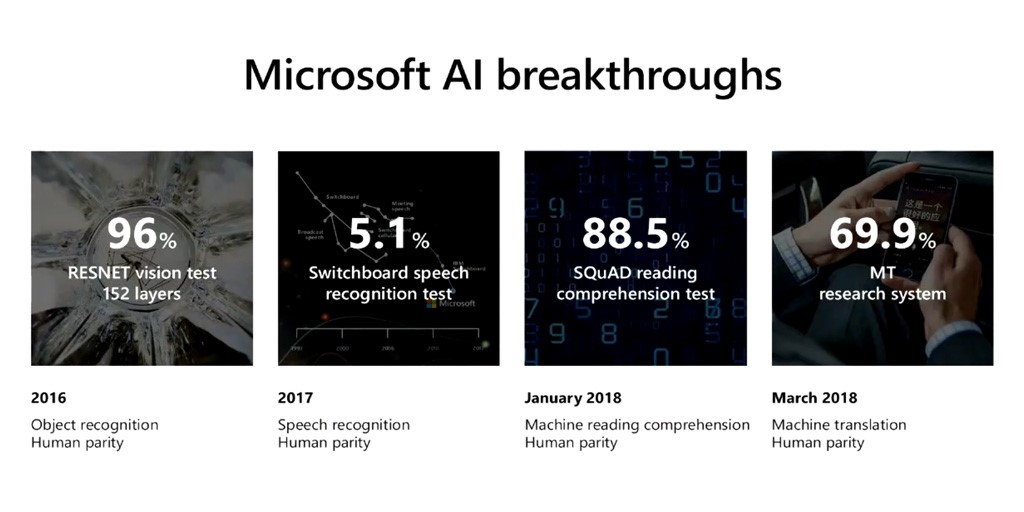
9:44
Nadella: All computing infrastructure is going to be used to build AI. At Microsoft Research we have been at the forefront of some amazing breakthroughs. The pace of those breakthroughs, most of that has been driven by availability of data and algorithms. We were first to achieve human parity in speech and translation.
How are we going to make all of this available so developers across the world can build applications? With Azure, we have taken all of this and made them services available to you. You want to build an application with computer vision, you take our cognitive services and train it in the edge. That ability to take AI wherever you need it is what it’s all about.
9:41
Nadella: We want to create technology so our customers can go and create technology. That was true when Paul and Bill set up the company, and it’s true today.
Technology for technology’s sake is not going to do anything, it’s about how you empower your own employees, how you transform your operations, products and services. That’s the goal. How do we give you those building blocks?
We are building Azure as the world’s computer. We have more than 54 global regions – multiple data centres – more than any other provider, so you have that capacity anywhere to deploy your applications. In Europe we have 8 regions, 6 more coming. In UK we have 2 – in Cardiff and London.
We have put a data centre off the coast of Scotland – it’s underwater, it’s sustainable, it was fast to build. it took just 90 days. This is the way we will think abut data centre regions and expansion.
The most interesting this in the cloud is happening at the edge.
9:37
Nadella: It takes a diverse group to create technology. Every walk of life, every part of industry and economy is being digitised. There isn’t a place not being digitised, no industry that’s not being transformed by technology. That’s an opportunity.
Every company will have to have what I call “Tech Intensity”. We must adopt technology in ways that are much faster than what we have done in the past. We don’t stop there. Each one of us, in our organisations, will have to build our own digital capability on top of the technology we have adopted. Tech Intensity is one of the key considerations you have to get right.
9:32
Satya is on stage!
9:31
CTO Michael Wignall takes to the stage. He says today’s event is about the intelligently amplified future. He’s introducing Satya Nadella.
9:30
It’s almost time for Satya Nadella, and we are ready:
9:25
Five minutes until Day Two of Future Decoded gets under way…
9:18
Here’s one of our infographics, rounding up Azure EVP Jason Zander‘s talk yesterday:
9:11
The exhibition hall is filling up, with visitors trying out Surface devices, HoloLens, and finding out more about Microsoft’s partners and customers, including Transport for London.
9:00
If you’re heading to the ExCeL today, here is a little peek into what you can expect:
8:51
Microsoft UK CEO Cindy Rose:
So excited about our Day 2 lineup of speakers! #FutureDecoded #MicrosoftUK pic.twitter.com/sJ5Hrcbc3A
— Cindy Rose (@CindyRose) November 1, 2018
8:37
Keynotes kick off in just over 45 minutes. We’ll have all the latest from Microsoft CEO Satya Nadella.
8:30
Someone came fully prepared for Future Decoded:
Day 2 at @Microsoft #FutureDecoded sporting the lovely #SharePoint laces ???????? bring on the learning #RackspaceUK pic.twitter.com/yL7BdrxyrK
— Cassy Freeman (@cassymfreeman) November 1, 2018
8:18
Yesterday, Dr Maggie Aderin-Pocock spoke about the power of crazy dreams. The scientist, who has released a book entitled The Book of the Moon, wants to encourage young women to move into STEM.
“It’s a case of ‘Houston, we have a problem’,” she said. “Working as a space scientist, I have had problems recruiting people, let alone women.”
8:13
There were so many highlights from day one of Future Decoded. One of ours was Microsoft UK CEO Cindy Rose‘s keynote:
She said: “The world today produces more data than humans can make sense of. The cloud enables rapid understanding of this data and Microsoft is investing billions in the cloud. We need to adhere to clear principles when creating AI and we should look at what should we build with AI.
“We need to intensify our efforts to prepare today’s workforce for the jobs of tomorrow. Success tomorrow takes action today. We need to ensure no one is left behind.”
She also unveiled an AI Academy.
8:05
Microsoft released research yesterday showing that companies that have started to use AI are already outperforming organisations that have not by 5%.
Michael Wignall, Chief Technology Officer at Microsoft UK, said: “We’re just at the beginning of the AI journey. That 5% performance boost will start to accelerate, quickly.”
You can read the full report here.
8:00
Hello and welcome to live coverage of day two of Future Decoded. Keynotes kick off at 9:30am with Microsoft Chief Executive Satya Nadella.
Yesterday, Future Decoded heard from Microsoft UK CEO Cindy Rose, CTO Michael Wignall and EVP of Azure Jason Zander.
There was also plenty of news, with Microsoft publishing new research that’s shows UK firms are at risk of falling behind due to the lack of an AI strategy; a newpartnership with University of Cambridge to support AI research; and the expansion of the defending democracy program to the UK.





